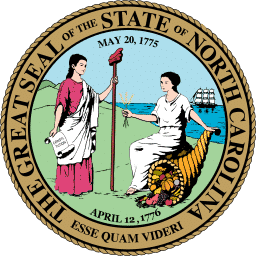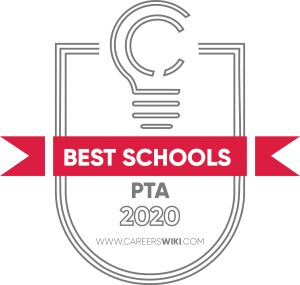…
There are 11 physical therapy assistant schools in North Carolina. They include technical and community colleges, which award associate’s degrees that prepare graduates to apply for licenses and seek employment.
The PTA programs provide all the instruction and training necessary to qualify as a practitioner in this state. Officials do not require additional education or work experience.
Physical therapy is a rapidly expanding field in the Tar Heel State. The federal government predicts there will be 410 annual job openings in the profession during the decade ending in 2026.
You Might Also Like:

This office, based in Raleigh, is a state government agency created to “establish and maintain minimum standards for the practice of physical therapy to protect the safety and welfare of the citizens of North Carolina.”
The governor appoints eight board members to three-year terms. There are four PTs, two PTAs, one medical doctor, and one public member.
The board sets rules governing who is eligible to apply for licensure, and issues licenses to PTs and PTAs. It investigates complaints of unauthorized practices and violations of the Physical Therapy Practice Act, and disciplines offenders.
Postsecondary institutions accept only those with high school diplomas or GEDs. Suggested high school courses include biology, anatomy and physiology, algebra, chemistry, and physics.
To become a physical therapy assistant, a student must earn a diploma in the field from an accredited postsecondary educational institution that the Commission on Accreditation in Physical Therapy Education (CAPTE) recognizes.
Most schools have programs that take about two years of full-time study to complete. They award either an associate of science (AS), an academic degree that prepares a student to be employed as a PTA; or an associate of applied science (AAS), an occupational degree designed to lead to more advanced education.
Every three years, PTAs are required to obtain 20 points of continuing education. This amounts to two CEUs, which consist of 20 contact hours or 20 course hours.
Graduates holding PTA degrees from accredited schools, with exam scores that meet the North Carolina passing level, need to send their school transcripts to the state board. They fill out a license application on the board’s website, provide two professional references, and pay an application fee.
The next step is to pass the online North Carolina Jurisprudence Exam, which assesses an applicant’s knowledge of North Carolina laws and regulations concerning physical therapy. This exam also may be downloaded from the board’s site.
Prospective PTAs then contact the Federation of State Boards of Physical Therapy (FSBPT) to obtain authorization to take the National Physical Therapy Examination (NPTE). They must verify having met educational requirements and passed the jurisprudence exam, pay a fee, and supply two character references.
Prometric Testing Centers administer the NPTE at sites in Greensboro, Greenville, Asheville, Raleigh, Charlotte, and Wilmington. Applicants need to contact the company to schedule the test and pay a fee.
The NPTE, conducted on computers, has 200 multiple-choice questions. A minimum score of 600, on a scale of 200-800, is required. The test covers interventions, diseases and conditions, therapeutic modalities, safety and protection, research and evidence-based practice, and professional responsibilities. It assesses students’ comprehension of the cardiovascular, pulmonary, lymphatic, musculoskeletal, and metabolic and endocrine systems..
The FSBPT reports exam results to the state board, which determines whether applicants are eligible for licensure.
PTAs in North Carolina are required to renew their licenses every year. They must demonstrate “continuing competence” by passing a Law and Ethics for the Physical Therapist course. The class covers ethical principles, the American Physical Therapy Association code of ethics, ethical decision-making processes, and common legal questions regarding physical therapy.
We selected the schools below based on the programs that they offer, accreditation, student population, graduation rate and reputation.
View our Ranking Methodology to learn more about how we rank schools.

18%
837
This school in Williamston offers an AAS degree program with highly selective admissions policies.
Applicants compete for up to 16 seats each fall. While grades and placement test scores are important factors, an effective interview with school officials can give a student a majority of the 20 points required for consideration. Having been an observer in a PT facility enhances an applicant’s qualifications for admission.
The college touts its “state-of-the-art” equipment, such as computerized ultrasound, electrical stimulation, mechanical traction, whirlpools, computerized treadmills and step machines, and electronic isokinetic technology.
17%
2966
PTA students on the campus in Rocky Mount complete 73 credit hours to earn AAS degrees. The five-semester program includes four clinical experiences.
Applicants must be certified in CPR and show evidence of having at least 40 hours’ experience observing in a PT facility. The program admits about 22 students each year. Nearly all of those who are accepted graduate, pass the licensure exam, and secure employment in the field within a year.
In addition to the usual core courses, students must take Introduction to Computers, Writing and Inquiry, Precalculus Algebra, and Public Speaking.
23%
3495
Located in Hudson, this school offers a 75-credit-hour AAS program consisting of six semesters, including two summer sessions.
The curriculum features general education and technical course phases. Among the required classes are Study and Success Skills, Writing and Inquiry, Introduction to Interpersonal Communication, and Conceptual Physics (with a lab).
Program applicants must have spent 24 hours observing in a PT facility. Students receive training during four clinical rotations.
29%
3021
This is a technical institute in the historic small city of New Bern.
The PTA program, which accepts 20 students annually, entails five semesters with 72 credit hours. In addition to typical core coursework, there are required classes in College Student Success, Critical Thinking, Introduction to Ethics, Math Measurement & Literature, Interpersonal Communication, Public Speaking, and Writing and Inquiry. The curriculum concludes with three clinical rotations.
Applicants must have 20 hours’ unpaid experience observing in two PT settings. The program boasts a 100 percent employment rate within six months of graduation.
30%
3236
This school is in the tiny northwestern North Carolina community of Dobson.
No more than 16 students are accepted each fall for the five-semester, 76-credit-hour program. Applicants must have 20 hours’ experience observing in a PT facility. Those with 400 hours of employment as a PT aide or technician receive bonus points in the selection process. They also get credit for holding a massage and bodywork therapist license, and for having taken sports medicine classes.
Core courses include Concept Physics (with a lab), Writing and Inquiry, Geriatrics, and Pediatrics.
41%
2464
The PTA program at this school in Sylva boasts “small classes and individual attention,” with “up-to-date teaching methodologies and state-of-the-industry equipment.”
Students complete 76 credit hours in five semesters, which takes two years, to earn AAS degrees. The program enrolls 16 class members in the fall.
In addition to the usual required coursework, students must take Writing and Inquiry, Health Science Physics, Professional Registering and Reporting, and Critical Thinking. Classes in geriatric and pediatric PT are also available. Students may take 15 percent of the courses online.
26%
5819
Located in Salisbury, RCCC offers a five-semester, 74-credit-hour AAS program that begins in the spring.
The school “strongly” recommends that program applicants take general education courses, as well as a college biology class, beforehand to improve their chances of being accepted.. Pre-admission requirements include 20 hours of observing at outpatient and inpatient facilities, and passing the Health Occupations Aptitude Exam.
In addition to the common core courses, students must take Writing and Inquiry, Critical Thinking, Quantitative Literacy, Geriatrics, Pediatrics, and either Introduction to Personal Communication or Public Speaking.
20%
10072
Classes and labs for the PTA program here are on the main campus in Jamestown.
The four-semester AAS program involves 69 credit hours. Applicants receive more points in the selection process if they have completed the high school Career and Technical Education concentration in the Health Sciences Pathway.
Students take prerequisite classes in biology, physiology, psychology, English, and humanities or fine arts. Among the core courses are Writing and Inquiry, Conceptual Physics (with a lab), and one of the following: Introduction to Communication, Introduction to Interpersonal Communication, Public Speaking, Writing and Research in the Disciplines, or Professional Research and Reporting.
20%
11660
This large school, just outside the city, offers a five-semester AAS program with 71 credit hours.
Prerequisite courses are two units of algebra, and one unit each of biology and chemistry. Besides the regular required classes, students must take Introduction to Personal Communication, Public Speaking, and a humanities or fine arts elective.
Those seeking to enter the program may attend an optional Health Applicant Counseling Session, in person or online; in addition to the required information session on campus. Students earn points in the selection process for having 10-20 hours’ experience “shadowing a PT or PTA.”
18%
19100
Our top-ranked school provides a five-semester, 75-credit-hour AAS program on its Central Campus in uptown Charlottesville. CPCC is one of the largest and oldest community colleges in the state.
Students practice patient screenings such as muscle testing, musculoskeletal measurements, symptom identification, and gait analysis. They learn therapeutic techniques like hot and cold compression, massage and stretching, posture training, ultrasound, and electrical simulation.
Some classes are available online. Students take part in four clinical rotations. The program enrolls 32 applicants each year, and all of them have passed the licensure exam and found jobs in recent years.
Schools offer instruction in classrooms and labs, as well as practical experience in real-world settings like hospitals, outpatient centers, and nursing homes.
The core coursework is about the same at all the schools. Commonly required classes include Anatomy and Physiology, General Psychology, PT Procedures, Therapeutic Exercise, Pathology, Health Care Resources, and Functional Anatomy.
Programs accept a minority of applicants—often between 16 and 32 students per year. Previous grades and test scores, as well as healthcare training, are key factors in the selection process. Applicants can approve their odds by taking certain pre-admission courses and getting some practical experience.
Some schools stipulate that incoming students must have worked, volunteered, or observed in a PT facility. Among the typical entrance requirements are a certain high school GPA, character references, essays, a physical exam and drug screening, immunizations, a criminal background check, malpractice insurance, and an on-campus interview. Some schools mandate that applicants hold CPR certificates.
Most programs require general education courses in English, math, science, humanities, and social sciences. In some cases, high scores on placement tests allow students to opt out of some of these classes. Applicants may be asked to take the Test of Essential Academic Skills.
$28
$60,000
26%
The average PTA in this state makes a salary of about $60,000 or an hourly wage of about $28.50, a bit better than the national median of about $57,500 and less than $28.
The top 10 percent of earners receive more than $77,100 (over $37 per hour) in North Carolina, somewhat less than the national median of about $79,400 and over $38. The bottom 10 percent get more than $43,700 yearly or over $21 hourly in the state, compared with about $36,000 and more than $17 nationally.
According to the U.S. Bureau of Labor Statistics, the number of PTA positions in North Carolina will increase from 2,570 in 2016 to 3,220 in 2026. That would be a job-growth rate of 26 percent, slower than the 31 percent the agency expects nationwide but faster than most other professions.
Sources: U.S. Bureau of Labor Statistics, CareerOneStop

LIMITED TIME DEAL